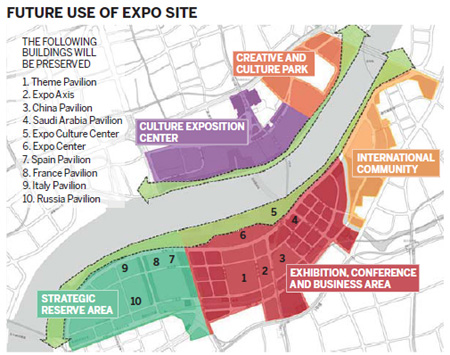Society
Expo site to remain cultural hub
By Qian Yanfeng (China Daily)
Updated: 2011-03-16 07:53
 |
Large Medium Small |
|
 The Expo Culture Center, China Pavilion, Expo Axis and Expo Center (from left) stand next to the Huangpu River. The area surrounding the buildings will be converted into an exhibition, conference and business area in line with new draft plans released on Tuesday. Guo Changyao / Xinhua |
BEIJING - Sustainability will be one of the main themes when Shanghai's World Expo site is redeveloped as a cultural hub, the city announced on Tuesday.
|
||||
The vision for the site and its surrounding areas was displayed on the website of the Shanghai municipal bureau of planning and land resources and members of the public are being encouraged to offer comments. The draft is being simultaneously exhibited at the Shanghai Urban Planning Exhibition Center, said the bureau.
People will get the chance to comment during the following three months, after which a more detailed document will be drawn up that will take into account both feedback from the public and potential bids for the design of each section.
Under the plan, the site in the heart of the city that spans the Huangpu River will be redeveloped into a center for international culture exchanges, a tourist and exhibition destination and a hub for the global and regional headquarters of leading companies and organizations.
More specifically, the 0.42-sq-km Urban Best Practice Area on the Puxi side of the Expo site will be converted into a creative and cultural park. Organizers will try to attract the world's leading creative studios and designers to set up their offices there. The area will also host a number of international festivals and celebrations.
|
 |
The 0.93-sq-km section housing corporate pavilions that is also on the Puxi side of the river will feature a number of industrial relics that were retained during the construction of the Expo site. It will be turned into a cultural exposition center that organizers hope will rival the Washington DC-based Smithsonian Institution and Berlin-based Museuminsel, which are among the world's largest museum and research complexes.
Under the draft plan, the area will feature local outlets of international art museums - such as the Guggenheim Museum and the Tate Gallery. World renowned architects will be asked to design landmark structures to demonstrate the international appeal of Shanghai's culture.
On the Pudong side, the area that is home to the China Pavilion and the Expo Culture Center, which measures 1.94 sq km, will be transformed into a major exhibition, conference and business center that will be similar to the famed Lujiazui Finance and Trade Zone, where office buildings will be complemented with amenities such as restaurants and hotels.
Next to it, the 0.63-sq-km Expo Village area will be developed into an international community where future inhabitants will live among shopping, education and entertainment centers.
According to the plan, the authorities have also set aside the 1.4-sq-km southernmost section of the Expo site, where the Houtan Wetland Park is located, as a strategic area that will be reserved for the city's sustainable development.
"This is to highlight our focus on sustainability. Instead of exploiting all the resources, we'd like to leave it open for future needs," Hong Hao, director-general of the Bureau of Shanghai World Expo Coordination, told China Daily earlier this month.
Meanwhile, the five foreign pavilions that will continue to stand on the site will remain Shanghai landmarks that are open to the public and will host exhibitions, as will the China Pavilion. Currently, the China Pavilion attracts more than 20,000 visitors a day during the week and 50,000 on weekends and holidays.
The five pavilions that will remain standing - those built by France, Italy, Russia, Saudi Arabia and Spain - were gifted to the city.
"I'm glad that we won't see many commercial properties rising in that area to add to the rising housing prices in the city," said Shanghai resident Yao Yun. "It's lucky that we will enjoy a high-end cultural and recreational center in the heart of the city in the near future."
Hong also said earlier that the multi-billion-yuan Expo probably turned a profit, although confirmation of the numbers rests with the National Audit Office and the bottom line may not be made public until May.



